

Compact Muon Solenoid
LHC, CERN
| CMS-EXO-21-004 ; CERN-EP-2024-059 | ||
| Searches for pair-produced multijet resonances using data scouting in proton-proton collisions at $ \sqrt{s} = $ 13 TeV | ||
| CMS Collaboration | ||
| 3 April 2024 | ||
| Submitted to Phys. Rev. Lett. | ||
| Abstract: Searches for pair-produced multijet signatures using data corresponding to an integrated luminosity of 128 fb$ ^{-1} $ of proton-proton collisions at $ \sqrt{s} = $ 13 TeV are presented. A data scouting technique is employed to record events with low jet scalar transverse momentum sum values. The electroweak production of particles predicted in $ R $-parity violating supersymmetric models is probed for the first time with fully hadronic final states. This is the first search for prompt hadronically decaying mass-degenerate higgsinos, and extends current exclusions on $ R $-parity violating top squarks and gluinos. | ||
| Links: e-print arXiv:2404.02992 [hep-ex] (PDF) ; CDS record ; inSPIRE record ; Physics Briefing ; CADI line (restricted) ; | ||
| Figures | |

png pdf |
Figure 1:
Benchmark RPV SUSY models for merged trijets (left), merged dijets (middle), and resolved trijets (right). The red circles group the final state quarks (or anti-quarks) according to the expected jet clustering of their hadronization products. |

png pdf |
Figure 1-a:
Benchmark RPV SUSY models for merged trijets (left), merged dijets (middle), and resolved trijets (right). The red circles group the final state quarks (or anti-quarks) according to the expected jet clustering of their hadronization products. |
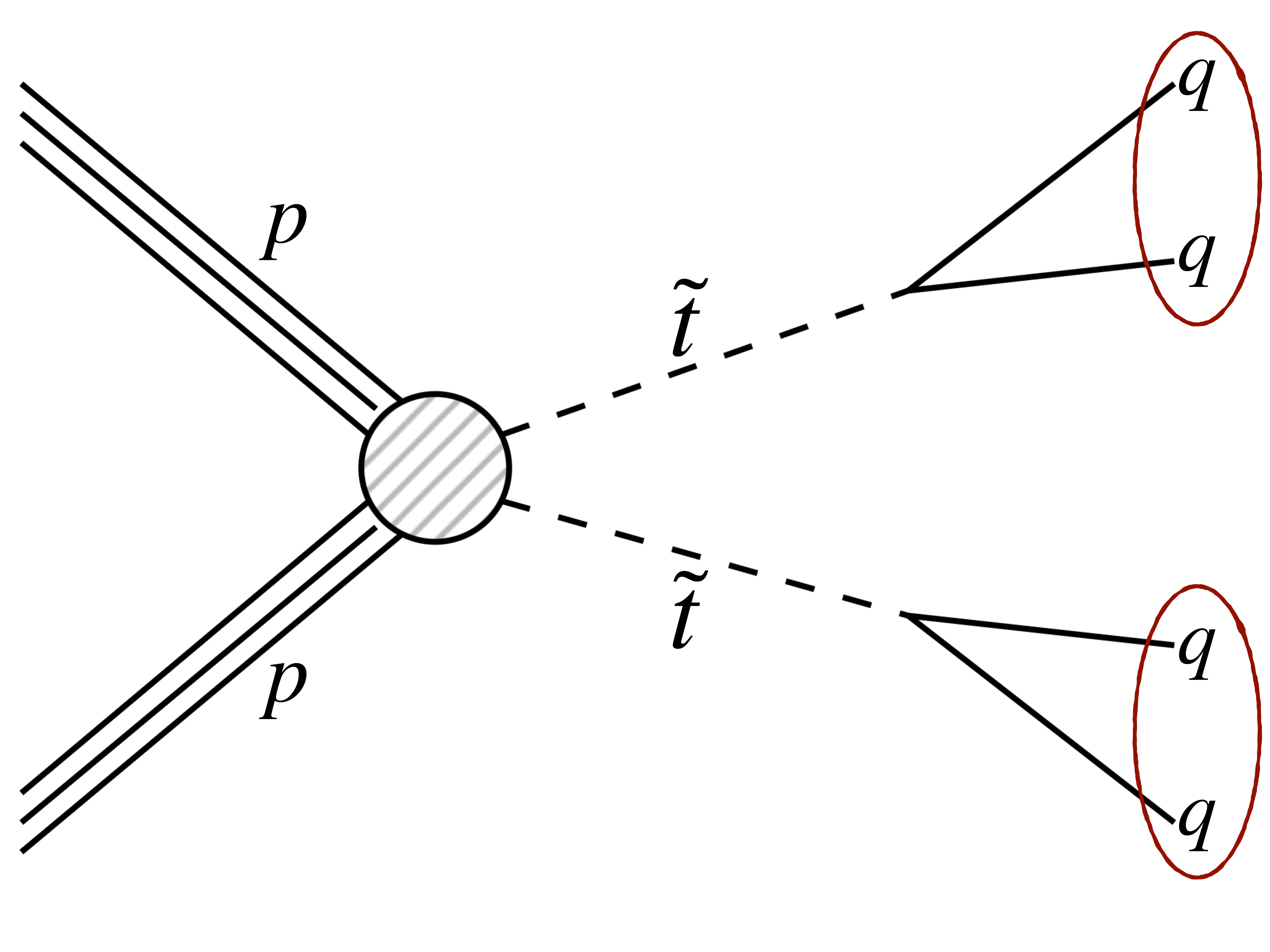
png pdf |
Figure 1-b:
Benchmark RPV SUSY models for merged trijets (left), merged dijets (middle), and resolved trijets (right). The red circles group the final state quarks (or anti-quarks) according to the expected jet clustering of their hadronization products. |

png pdf |
Figure 1-c:
Benchmark RPV SUSY models for merged trijets (left), merged dijets (middle), and resolved trijets (right). The red circles group the final state quarks (or anti-quarks) according to the expected jet clustering of their hadronization products. |
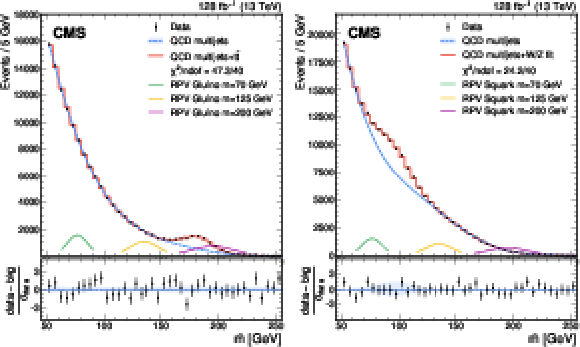
png pdf |
Figure 2:
The distribution of average jet mass in the data (points), for the search for pair-produced merged resonances decaying to trijets (left) and dijets (right), compared to a background-only prediction from GP regression (blue), and the full background fit including simulations (red) of SM resonances from $ \mathrm{t} \bar{\mathrm{t}} $ (left) and W/Z+ jets (right). Also shown are the expected shapes of signals from $ R $-parity violating gluinos with resonance masses 70 (green), 125 (yellow) and 200 GeV(purple), with arbitrary normalizations. The bottom panel shows the difference between the data and the final background estimate, divided by the statistical uncertainty of the data in each bin, with fit uncertainty shown in blue. |
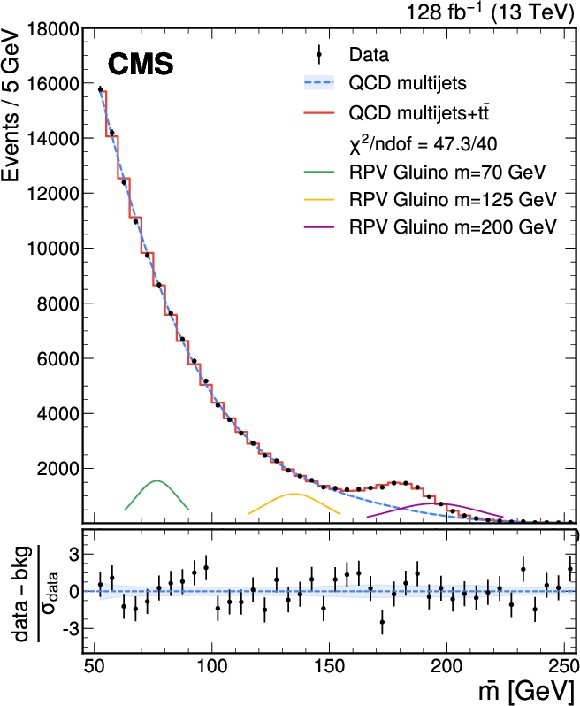
png pdf |
Figure 2-a:
The distribution of average jet mass in the data (points), for the search for pair-produced merged resonances decaying to trijets (left) and dijets (right), compared to a background-only prediction from GP regression (blue), and the full background fit including simulations (red) of SM resonances from $ \mathrm{t} \bar{\mathrm{t}} $ (left) and W/Z+ jets (right). Also shown are the expected shapes of signals from $ R $-parity violating gluinos with resonance masses 70 (green), 125 (yellow) and 200 GeV(purple), with arbitrary normalizations. The bottom panel shows the difference between the data and the final background estimate, divided by the statistical uncertainty of the data in each bin, with fit uncertainty shown in blue. |
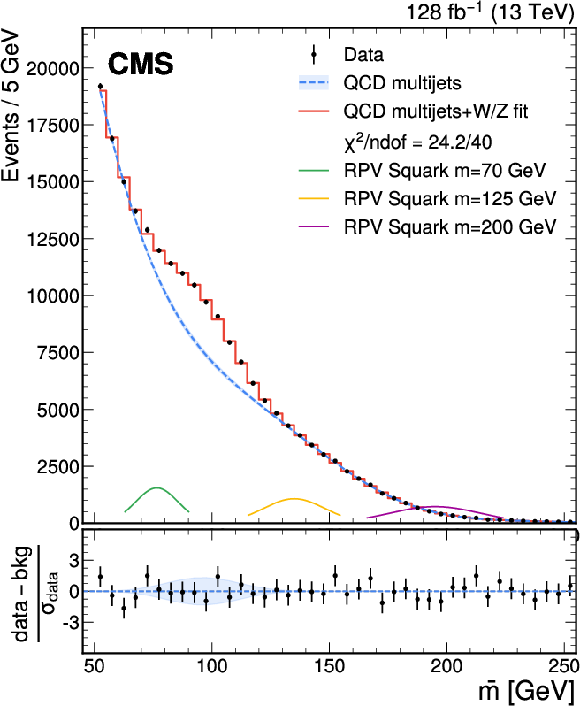
png pdf |
Figure 2-b:
The distribution of average jet mass in the data (points), for the search for pair-produced merged resonances decaying to trijets (left) and dijets (right), compared to a background-only prediction from GP regression (blue), and the full background fit including simulations (red) of SM resonances from $ \mathrm{t} \bar{\mathrm{t}} $ (left) and W/Z+ jets (right). Also shown are the expected shapes of signals from $ R $-parity violating gluinos with resonance masses 70 (green), 125 (yellow) and 200 GeV(purple), with arbitrary normalizations. The bottom panel shows the difference between the data and the final background estimate, divided by the statistical uncertainty of the data in each bin, with fit uncertainty shown in blue. |
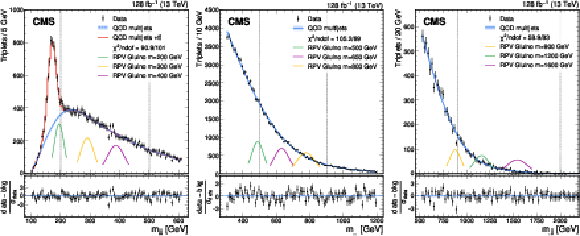
png pdf |
Figure 3:
The distribution of trijet mass in the data (points), for the three search regions (left, middle and right) for pair-produced resolved resonances decaying to trijets, compared to a background-only fit from GP regression (blue), and (left) the full background fit including simulation of a SM resonance from $ \mathrm{t} \bar{\mathrm{t}} $ production (red). Also shown are the expected shapes of signals from $ R $-parity violating gluinos at various masses (green, yellow and purple), with arbitrary normalizations. The search range is indicated by the vertical dashed lines. The bottom panel shows the difference in each bin between the data and the final background estimate, divided by the statistical uncertainty of the data, with fit uncertainty shown in blue. |

png pdf |
Figure 3-a:
The distribution of trijet mass in the data (points), for the three search regions (left, middle and right) for pair-produced resolved resonances decaying to trijets, compared to a background-only fit from GP regression (blue), and (left) the full background fit including simulation of a SM resonance from $ \mathrm{t} \bar{\mathrm{t}} $ production (red). Also shown are the expected shapes of signals from $ R $-parity violating gluinos at various masses (green, yellow and purple), with arbitrary normalizations. The search range is indicated by the vertical dashed lines. The bottom panel shows the difference in each bin between the data and the final background estimate, divided by the statistical uncertainty of the data, with fit uncertainty shown in blue. |
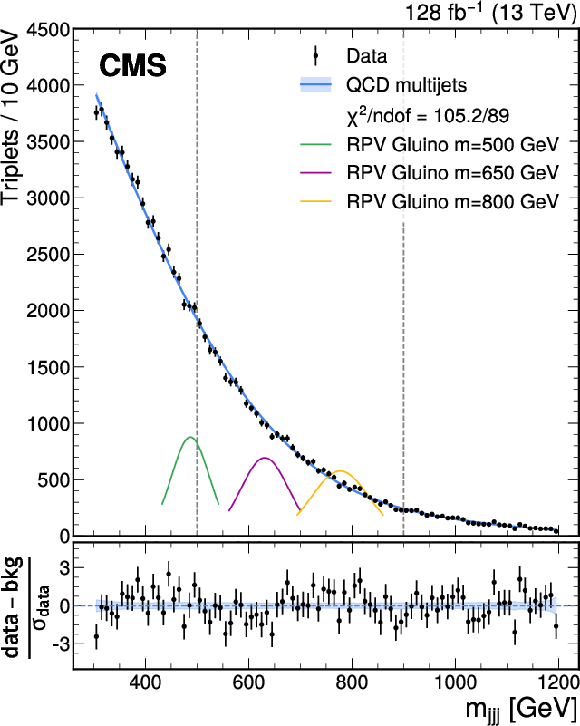
png pdf |
Figure 3-b:
The distribution of trijet mass in the data (points), for the three search regions (left, middle and right) for pair-produced resolved resonances decaying to trijets, compared to a background-only fit from GP regression (blue), and (left) the full background fit including simulation of a SM resonance from $ \mathrm{t} \bar{\mathrm{t}} $ production (red). Also shown are the expected shapes of signals from $ R $-parity violating gluinos at various masses (green, yellow and purple), with arbitrary normalizations. The search range is indicated by the vertical dashed lines. The bottom panel shows the difference in each bin between the data and the final background estimate, divided by the statistical uncertainty of the data, with fit uncertainty shown in blue. |

png pdf |
Figure 3-c:
The distribution of trijet mass in the data (points), for the three search regions (left, middle and right) for pair-produced resolved resonances decaying to trijets, compared to a background-only fit from GP regression (blue), and (left) the full background fit including simulation of a SM resonance from $ \mathrm{t} \bar{\mathrm{t}} $ production (red). Also shown are the expected shapes of signals from $ R $-parity violating gluinos at various masses (green, yellow and purple), with arbitrary normalizations. The search range is indicated by the vertical dashed lines. The bottom panel shows the difference in each bin between the data and the final background estimate, divided by the statistical uncertainty of the data, with fit uncertainty shown in blue. |

png pdf |
Figure 4:
Observed limits (points) and expected limits (dashed curves) on the product of the production cross section ($ \sigma $), branching fraction (B), and acceptance (A) for pair produced merged trijets (left), merged dijets (middle), and pair produced resolved trijets right). The vertical lines on the resolved three quark resonance limits (right) indicate the different search regions. The limits are compared to theoretical predictions for the pair production of $ R $-parity violating gluinos (red in left and right), mass degenerate higgsinos (blue in left), and top squarks (red in middle). |

png pdf |
Figure 4-a:
Observed limits (points) and expected limits (dashed curves) on the product of the production cross section ($ \sigma $), branching fraction (B), and acceptance (A) for pair produced merged trijets (left), merged dijets (middle), and pair produced resolved trijets right). The vertical lines on the resolved three quark resonance limits (right) indicate the different search regions. The limits are compared to theoretical predictions for the pair production of $ R $-parity violating gluinos (red in left and right), mass degenerate higgsinos (blue in left), and top squarks (red in middle). |
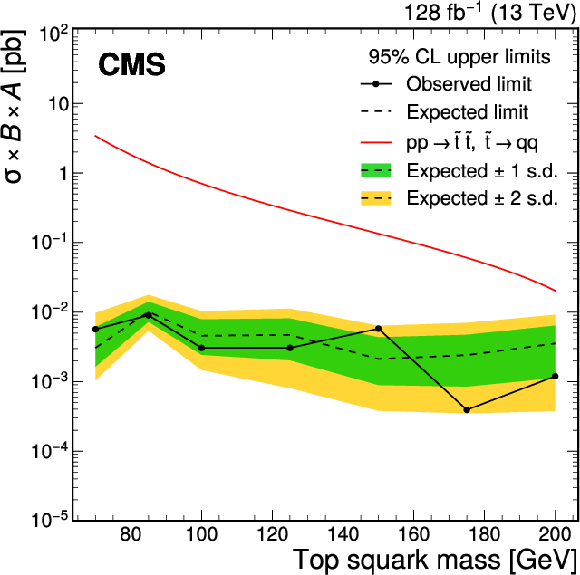
png pdf |
Figure 4-b:
Observed limits (points) and expected limits (dashed curves) on the product of the production cross section ($ \sigma $), branching fraction (B), and acceptance (A) for pair produced merged trijets (left), merged dijets (middle), and pair produced resolved trijets right). The vertical lines on the resolved three quark resonance limits (right) indicate the different search regions. The limits are compared to theoretical predictions for the pair production of $ R $-parity violating gluinos (red in left and right), mass degenerate higgsinos (blue in left), and top squarks (red in middle). |
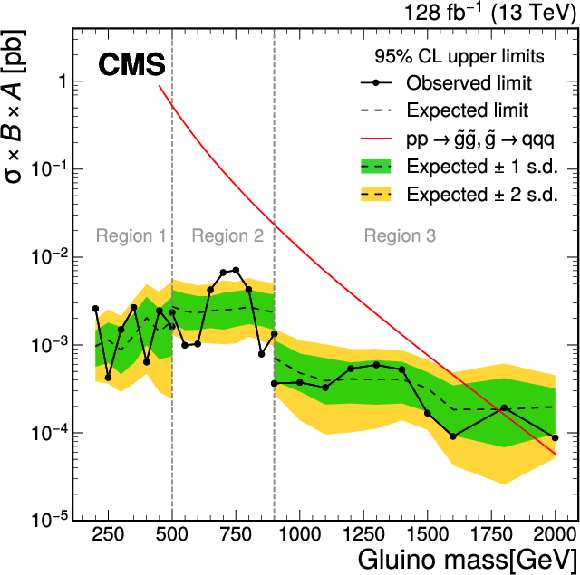
png pdf |
Figure 4-c:
Observed limits (points) and expected limits (dashed curves) on the product of the production cross section ($ \sigma $), branching fraction (B), and acceptance (A) for pair produced merged trijets (left), merged dijets (middle), and pair produced resolved trijets right). The vertical lines on the resolved three quark resonance limits (right) indicate the different search regions. The limits are compared to theoretical predictions for the pair production of $ R $-parity violating gluinos (red in left and right), mass degenerate higgsinos (blue in left), and top squarks (red in middle). |
| Tables | |

png pdf |
Table 1:
Selection requirements for the resolved trijet resonance search listed for the three regions of three-jet resonance mass. |
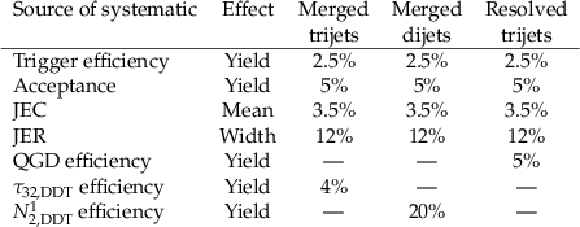
png pdf |
Table 2:
Summary of the systematic uncertainties in the signal yield and shape, for the searches for merged three and two quark, and resolved trijet resonances. |
| Summary |
| In summary, a search has been performed for pair-produced multijet resonances using data scouting, where the jets in the final state can be either merged or resolved individually. This search accurately reconstructs the hadronic decays of the top quark and W, Z bosons, in agreement with SM expectations. New, additional resonances were not observed, with the largest excess consistent with a three jet resonance mass of 770 GeV, but with a local significance of only 2.6 standard deviations. This search extends the previous limits on $ R $-parity violating models of top squarks and gluinos, and sets the first exclusion limits on $ R $-parity violating mass-degenerate, prompt, and hadronically decaying higgsinos. |
| References | ||||
| 1 | CMS Collaboration | Observation of a new boson at a mass of 125 GeV with the CMS experiment at the LHC | PLB 716 (2012) 30 | CMS-HIG-12-028 1207.7235 |
| 2 | CMS Collaboration | Observation of a new boson with mass near 125 GeV in pp collisions at $ \sqrt{s}= $ 7 and 8 TeV | JHEP 06 (2013) 081 | CMS-HIG-12-036 1303.4571 |
| 3 | ATLAS Collaboration | Observation of a new particle in the search for the Standard Model Higgs boson with the ATLAS detector at the LHC | PLB 716 (2012) 1 | 1207.7214 |
| 4 | Super-Kamiokande Collaboration | Evidence for oscillation of atmospheric neutrinos | PRL 81 (1998) 1562 | hep-ex/9807003 |
| 5 | Muon $g{-}2$ Collaboration | Measurement of the positive muon anomalous magnetic moment to 0.46 ppm | PRL 126 (2021) 141801 | |
| 6 | LHCb Collaboration | Test of lepton universality in beauty-quark decays | Nature Phys. 18 (2022) 277 | 2103.11769 |
| 7 | R. Barbier et al. | R-parity violating supersymmetry | Phys. Rept. 420 (2005) 1 | hep-ph/0406039 |
| 8 | H. Easa, T. Gregoire, and D. Stolarski | New limits on coloured three jet resonances | JHEP 09 (2020) 131 | 2003.00014 |
| 9 | CMS Collaboration | Precision luminosity measurement in proton-proton collisions at $ \sqrt{s} = $ 13 TeV in 2015 and 2016 at CMS | EPJC 81 (2021) 800 | CMS-LUM-17-003 2104.01927 |
| 10 | CMS Collaboration | CMS luminosity measurement for the 2017 data-taking period at $ \sqrt{s} = $ 13 TeV | CMS Physics Analysis Summary, 2018 link |
CMS-PAS-LUM-17-004 |
| 11 | CMS Collaboration | CMS luminosity measurement for the 2018 data-taking period at $ \sqrt{s} = $ 13 TeV | CMS Physics Analysis Summary, 2019 link |
CMS-PAS-LUM-18-002 |
| 12 | S. Mukherjee | Data Scouting: A new Trigger Paradigm | CMS Collaboration, in 5th Large Hadron Collider Physics Conference. 8, 2017 | 1708.06925 |
| 13 | CDF Collaboration | First search for multijet resonances in $ \sqrt{s} = $ 1.96 TeV $ p\bar{p} $ collisions | PRL 107 (2011) 042001 | 1105.2815 |
| 14 | ATLAS Collaboration | Search for massive supersymmetric particles decaying to many jets using the ATLAS detector in $ pp $ collisions at $ \sqrt{s} = $ 8 TeV | PRD 91 (2015) 112016 | 1502.05686 |
| 15 | ATLAS Collaboration | Search for R-parity-violating supersymmetric particles in multi-jet final states produced in $ pp $ collisions at $ \sqrt{s} = $ 13 TeV using the ATLAS detector at the LHC | PLB 785 (2018) 136 | 1804.03568 |
| 16 | CMS Collaboration | Search for three-jet resonances in pp collisions at $ \sqrt{s}= $ 7 TeV | PLB 718 (2012) 329 | CMS-EXO-11-060 1208.2931 |
| 17 | CMS Collaboration | Searches for light- and heavy-flavour three-jet resonances in pp collisions at $ \sqrt{s} = $ 8 TeV | PLB 730 (2014) 193 | CMS-EXO-12-049 1311.1799 |
| 18 | CMS Collaboration | Search for pair-produced three-jet resonances in proton-proton collisions at $ \sqrt{s} = $ 13 TeV | PRD 99 (2019) 012010 | CMS-EXO-17-030 1810.10092 |
| 19 | ATLAS Collaboration | A search for top squarks with R-parity-violating decays to all-hadronic final states with the ATLAS detector in $ \sqrt{s} = $ 8 TeV proton-proton collisions | JHEP 06 (2016) 067 | 1601.07453 |
| 20 | ATLAS Collaboration | A search for pair-produced resonances in four-jet final states at $ \sqrt{s} = $ 13 TeV with the ATLAS detector | EPJC 78 (2018) 250 | 1710.07171 |
| 21 | ATLAS Collaboration | Search for pair production of massive particles decaying into three quarks with the ATLAS detector in $ \sqrt{s}= $ 7 TeV $ pp $ collisions at the LHC | JHEP 12 (2012) 086 | 1210.4813 |
| 22 | CMS Collaboration | Search for pair-produced resonances decaying to jet pairs in proton-proton collisions at $ \sqrt{s} = $ 8 TeV | PLB 747 (2015) 98 | CMS-EXO-12-052 1412.7706 |
| 23 | CMS Collaboration | Search for pair-produced resonances decaying to quark pairs in proton-proton collisions at $ \sqrt{s}= $ 13 TeV | PRD 98 (2018) 112014 | CMS-EXO-17-021 1808.03124 |
| 24 | CMS Collaboration | Search for pair-produced dijet resonances in four-jet final states in pp collisions at $ \sqrt{s} = $ 7 TeV | PRL 110 (2013) 141802 | CMS-EXO-11-016 1302.0531 |
| 25 | CMS Collaboration | Search for resonant and nonresonant production of pairs of dijet resonances in proton-proton collisions at $ \sqrt{s} = $ 13 TeV | JHEP 07 (2023) 161 | CMS-EXO-21-010 2206.09997 |
| 26 | CMS Collaboration | HEPData record for this analysis | link | |
| 27 | CMS Collaboration | The CMS experiment at the CERN LHC | JINST 3 (2008) S08004 | |
| 28 | CMS Collaboration | Performance of the CMS level-1 trigger in proton-proton collisions at $ \sqrt{s} = $ 13 TeV | JINST 15 (2020) P10017 | CMS-TRG-17-001 2006.10165 |
| 29 | CMS Collaboration | The CMS trigger system | JINST 12 (2017) P01020 | CMS-TRG-12-001 1609.02366 |
| 30 | CMS Collaboration | Electron and photon reconstruction and identification with the CMS experiment at the CERN LHC | JINST 16 (2021) P05014 | CMS-EGM-17-001 2012.06888 |
| 31 | CMS Collaboration | Performance of the CMS muon detector and muon reconstruction with proton-proton collisions at $ \sqrt{s}= $ 13 TeV | JINST 13 (2018) P06015 | CMS-MUO-16-001 1804.04528 |
| 32 | CMS Collaboration | Description and performance of track and primary-vertex reconstruction with the CMS tracker | JINST 9 (2014) P10009 | CMS-TRK-11-001 1405.6569 |
| 33 | CMS Collaboration | Particle-flow reconstruction and global event description with the CMS detector | JINST 12 (2017) P10003 | CMS-PRF-14-001 1706.04965 |
| 34 | CMS Collaboration | Performance of reconstruction and identification of $ \tau $ leptons decaying to hadrons and $ \nu_\tau $ in pp collisions at $ \sqrt{s}= $ 13 TeV | JINST 13 (2018) P10005 | CMS-TAU-16-003 1809.02816 |
| 35 | CMS Collaboration | Jet energy scale and resolution in the CMS experiment in $ pp $ collisions at 8 TeV | JINST 12 (2017) P02014 | CMS-JME-13-004 1607.03663 |
| 36 | CMS Collaboration | Performance of missing transverse momentum reconstruction in proton-proton collisions at $ \sqrt{s} = $ 13 TeV using the CMS detector | JINST 14 (2019) P07004 | CMS-JME-17-001 1903.06078 |
| 37 | J. Alwall et al. | The automated computation of tree-level and next-to-leading order differential cross sections, and their matching to parton shower simulations | JHEP 07 (2014) 079 | 1405.0301 |
| 38 | J. Alwall et al. | Comparative study of various algorithms for the merging of parton showers and matrix elements in hadronic collisions | EPJC 53 (2008) 473 | 0706.2569 |
| 39 | T. Sjöstrand et al. | An introduction to PYTHIA 8.2 | Comput. Phys. Commun. 191 (2015) 159 | 1410.3012 |
| 40 | CMS Collaboration | Extraction and validation of a new set of CMS PYTHIA8 tunes from underlying-event measurements | EPJC 80 (2020) 4 | CMS-GEN-17-001 1903.12179 |
| 41 | NNPDF Collaboration | Parton distributions for the LHC Run II | JHEP 04 (2015) 040 | 1410.8849 |
| 42 | GEANT4 Collaboration | GEANT 4---a simulation toolkit | NIM A 506 (2003) 250 | |
| 43 | A. Gandrakota, A. Lath, A. V. Morozov, and S. Murthy | Model selection and signal extraction using Gaussian process regression | JHEP 02 (2023) 230 | 2202.05856 |
| 44 | M. Cacciari, G. P. Salam, and G. Soyez | FastJet user manual | EPJC 72 (2012) 1896 | 1111.6097 |
| 45 | M. Cacciari and G. P. Salam | Dispelling the $ N^{3} $ myth for the $ k_t $ jet-finder | PLB 641 (2006) 57 | hep-ph/0512210 |
| 46 | M. Cacciari, G. P. Salam, and G. Soyez | The anti-$ k_{\mathrm{T}} $ jet clustering algorithm | JHEP 04 (2008) 063 | 0802.1189 |
| 47 | CMS Collaboration | Pileup mitigation at CMS in 13 TeV data | JINST 15 (2020) P09018 | CMS-JME-18-001 2003.00503 |
| 48 | CMS Collaboration | Jet algorithms performance in 13 TeV data | CMS Physics Analysis Summary, 2017 CMS-PAS-JME-16-003 |
CMS-PAS-JME-16-003 |
| 49 | D. Krohn, J. Thaler, and L.-T. Wang | Jet trimming | JHEP 02 (2010) 084 | 0912.1342 |
| 50 | J. Thaler and K. Van Tilburg | Identifying boosted objects with N-subjettiness | JHEP 03 (2011) 015 | 1011.2268 |
| 51 | I. Moult, L. Necib, and J. Thaler | New angles on energy correlation functions | JHEP 12 (2016) 153 | 1609.07483 |
| 52 | J. Dolen et al. | Thinking outside the ROCs: Designing decorrelated taggers (DDT) for jet substructure | JHEP 05 (2016) 156 | 1603.00027 |
| 53 | CMS Collaboration | Search for low mass vector resonances decaying into quark-antiquark pairs in proton-proton collisions at $ \sqrt{s}= $ 13 TeV | JHEP 01 (2018) 097 | CMS-EXO-17-001 1710.00159 |
| 54 | CMS Collaboration | Search for low mass vector resonances decaying into quark-antiquark pairs in proton-proton collisions at $ \sqrt{s}= $ 13 TeV | PRD 100 (2019) 112007 | CMS-EXO-18-012 1909.04114 |
| 55 | CMS Collaboration | Search for Low-Mass Quark-Antiquark Resonances Produced in Association with a Photon at $ \sqrt {s} = $ 13 TeV | PRL 123 (2019) 231803 | CMS-EXO-17-027 1905.10331 |
| 56 | P. T. Komiske, E. M. Metodiev, and J. Thaler | Energy flow networks: Deep sets for particle jets | JHEP 01 (2019) 121 | 1810.05165 |
| 57 | C. E. Rasmussen and C. K. I. Williams | Gaussian processes for machine learning | The MIT Press, ISBN~9780262256834, 2005 link |
|
| 58 | M. Frate et al. | Modeling smooth backgrounds and generic localized signals with Gaussian processes | 2017 | 1709.05681 |
| 59 | G. Cowan, ``Statistics'', Ch. 39 in Particle Data Group , C. Patrignani et al. | Review of particle physics | Chin. Phys. C 40 (2016) 100001 | |
| 60 | ATLAS and CMS Collaborations, and LHC Higgs Combination Group | Procedure for the LHC Higgs boson search combination in Summer 2011 | Technical Report CMS-NOTE-2011-005, ATL-PHYS-PUB-2011-11, 2011 | |
| 61 | D. Foreman-Mackey, D. W. Hogg, D. Lang, and J. Goodman | emcee: The MCMC hammer | Publ. Astron. Soc. Pac. 125 (2013) 306 | 1202.3665 |
| 62 | G. Cowan, K. Cranmer, E. Gross, and O. Vitells | Asymptotic formulae for likelihood-based tests of new physics | EPJC 71 (2011) 1554 | 1007.1727 |
| 63 | A. L. Read | Presentation of search results: The CL$ _{\text{s}} $ technique | JPG 28 (2002) 2693 | |
| 64 | T. Junk | Confidence level computation for combining searches with small statistics | NIM A 434 (1999) 435 | hep-ex/9902006 |
| 65 | C. Borschensky et al. | Squark and gluino production cross sections in pp collisions at $ \sqrt{s} = $ 13, 14, 33 and 100 TeV | EPJC 74 (2014) 3174 | 1407.5066 |

|
Compact Muon Solenoid LHC, CERN |

|

|

|

|

|

|